In today’s rapidly evolving smart home ecosystem, smart switches have emerged as essential components that bridge traditional home infrastructure with modern automation capabilities. As we navigate through 2025, the smart switch market continues to demonstrate steady growth and technological advancement, creating significant opportunities for importers and manufacturers alike.
At SWITCH GO, a leading smart home technology company based in Shenzhen since our founding in 2019, we’ve been at the forefront of smart switch innovation with our philosophy of “Switch Smarter, Live Easier.” Our experience as both manufacturers and market participants provides us with unique insights into what makes smart switches an attractive product category with substantial commercial potential.
This comprehensive guide explores everything importers and manufacturers need to know about smart switches in 2025 – from market trends and certification requirements to technical specifications and manufacturing considerations. Whether you’re looking to enter this dynamic market or optimize your existing smart switch business, this article provides the essential knowledge to succeed.
Smart Switch Market Overview: Steady Growth and Expanding Applications
The global smart switch market has demonstrated consistent growth in recent years, with a clear upward trajectory projected through 2031. According to our analysis at SWITCH GO, the market valued at approximately $0.85 billion in 2024 is projected to reach $1.82 billion by 2031, growing at a compound annual growth rate (CAGR) of 9.3%.
Global Smart Switch Market Growth Forecast (2024-2031)
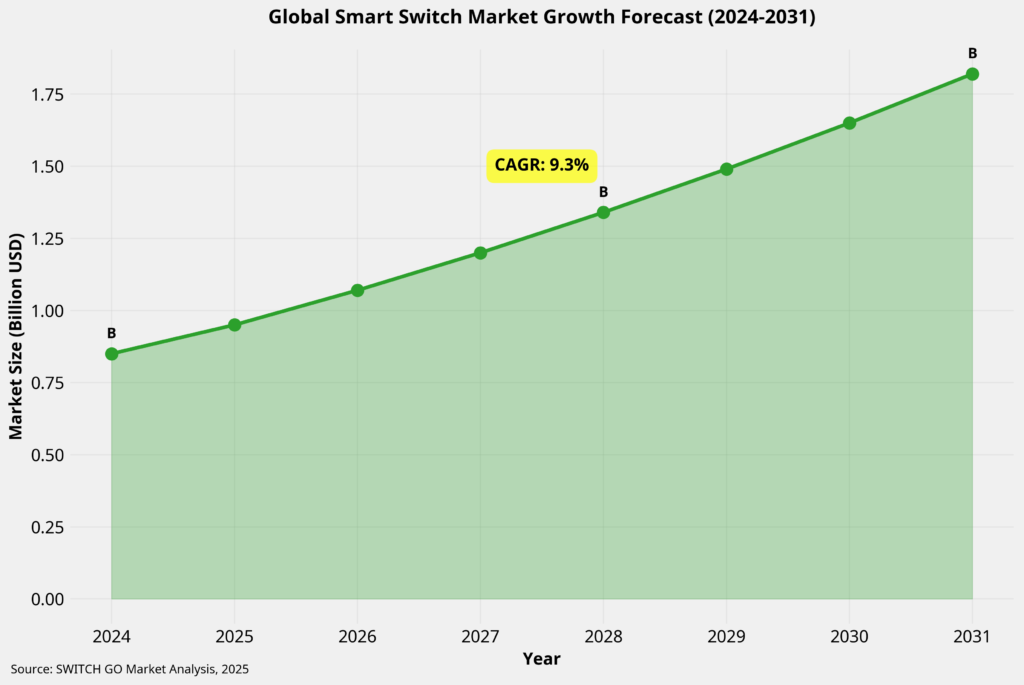
While this growth rate may appear modest compared to some other smart home categories, it represents a substantial opportunity for several reasons:
- Replacement cycle advantage: Unlike many smart home devices, switches are permanent fixtures that typically remain installed for years, creating a steady replacement market as consumers upgrade from traditional to smart switches.
- New construction integration: Smart switches are increasingly specified in new construction projects, creating a reliable growth channel independent of retrofit markets.
- Commercial applications expansion: Beyond residential use, smart switches are gaining traction in commercial, hospitality, and institutional settings, significantly expanding the total addressable market.
- Higher average selling prices: Smart switches command premium pricing compared to traditional switches, with margins that have remained relatively stable despite increased competition.
Regional analysis reveals interesting market dynamics. North America currently leads with approximately 40% market share, followed by Europe (30%) and Asia-Pacific (20%). However, the Asia-Pacific region is expected to witness the fastest growth, with China emerging as both a manufacturing powerhouse and rapidly growing consumer market.
For importers and manufacturers, understanding these regional differences is crucial. North American consumers typically prioritize voice assistant integration and mobile app functionality, while European buyers often place greater emphasis on energy monitoring features and aesthetic design. In Asia-Pacific markets, competitive pricing and multi-way control capabilities tend to be key purchasing factors.
The Compelling Case for Smart Switches vs. Traditional Switches
When advising importers and manufacturers about market opportunities, we at SWITCH GO often highlight the significant advantages smart switches offer over traditional alternatives. These advantages translate directly into consumer value propositions that drive adoption.
Smart Switches vs. Traditional Switches Comparison
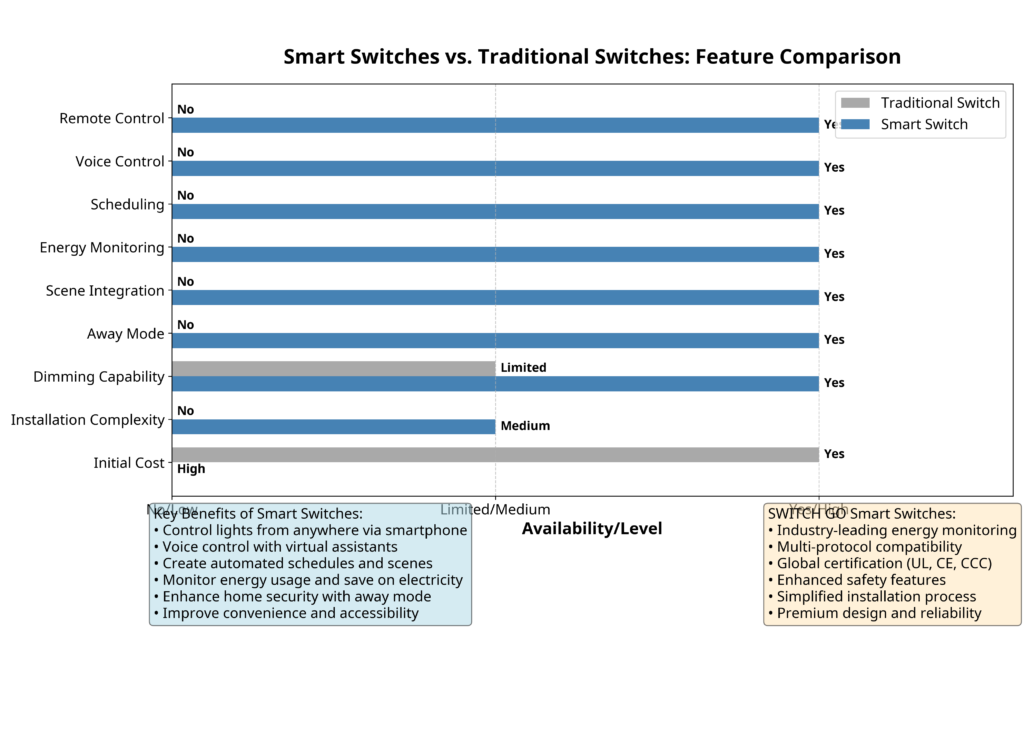
Design and Aesthetics
Smart switches have evolved significantly from their utilitarian beginnings. Modern designs now feature:
- Sleek, minimalist aesthetics: Clean lines and uncluttered interfaces that complement contemporary interior design.
- Customizable faceplates: Options for different colors, materials, and finishes to match various decor styles.
- Status indicators: Subtle LED indicators that provide functionality feedback without being visually intrusive.
- Touch and gesture controls: Advanced models replacing physical buttons with touch-sensitive surfaces or gesture recognition.
These design improvements address a key consumer pain point with early smart switches, which often looked overly technical or clashed with home decor.
Installation Flexibility
While installation complexity was once a significant barrier to adoption, modern smart switches offer several installation advantages:
- No-neutral wire options: Advanced designs that can operate without neutral wires, making them compatible with older homes.
- Retrofit-friendly dimensions: Form factors designed to fit existing switch boxes without modifications.
- Simplified wiring: Color-coded terminals and clear instructions reducing installation complexity.
- Professional installation networks: Partnerships with electricians and installers to provide expert installation services.
At SWITCH GO, our switches are designed with both DIY enthusiasts and professional installers in mind, with clear documentation and support resources for both audiences.
Enhanced Functionality
The functionality gap between smart and traditional switches continues to widen:
- Remote control: Operation from anywhere via smartphone apps.
- Scheduling and automation: Time-based or condition-based operation without user intervention.
- Scene integration: Incorporation into broader home scenes (e.g., “Movie Night” or “Good Morning”).
- Dimming capabilities: Precise light level control without requiring special dimming bulbs.
- Usage monitoring: Tracking of energy consumption and usage patterns.
These advanced capabilities transform switches from simple on/off mechanisms to intelligent control points within the home.
Ecosystem Compatibility
Perhaps the most significant advantage of smart switches is their integration potential:
- Voice assistant compatibility: Operation via Amazon Alexa, Google Assistant, and Apple HomeKit.
- Smart home platform integration: Compatibility with platforms like SmartThings, Home Assistant, and others.
- IFTTT and custom automation: Support for if-this-then-that logic and custom automation rules.
- Cross-device coordination: Ability to trigger or respond to other smart home devices.
At SWITCH GO, we ensure our switches are compatible with all major smart home ecosystems, including Tuya, EweLink, Amazon Alexa, Google Home, and SmartThings, maximizing their appeal to diverse consumer segments.
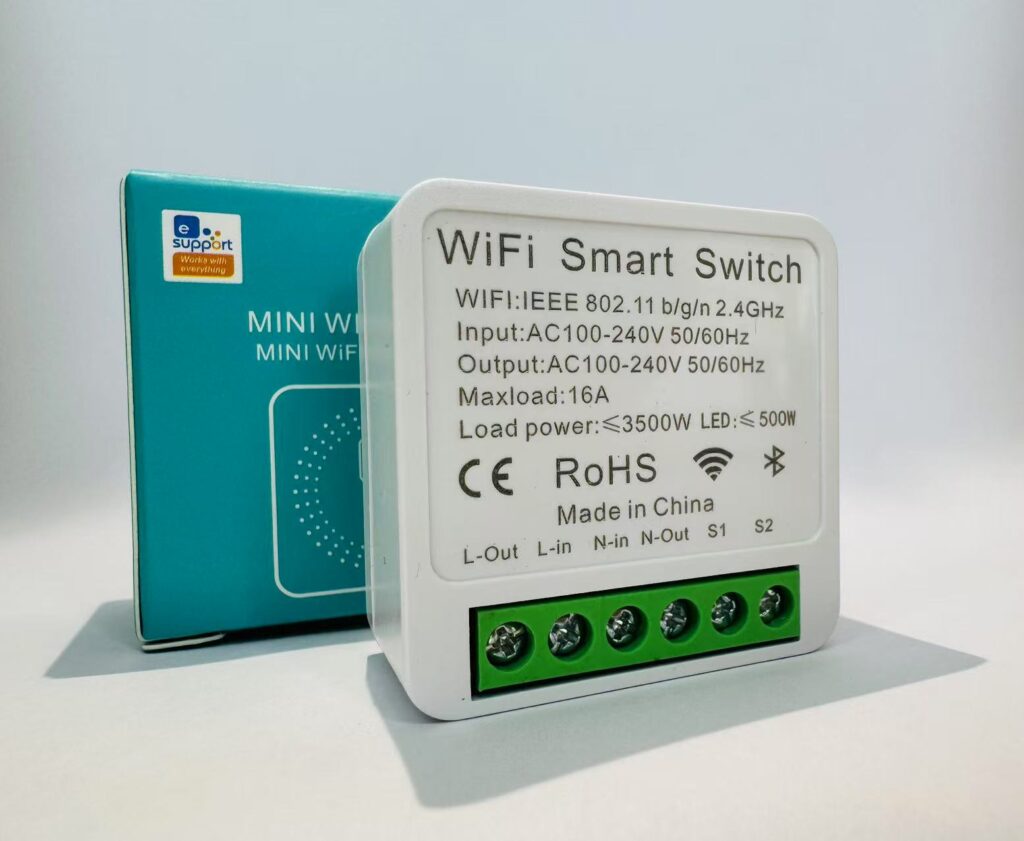
Our best-selling 16A Mini WiFi Smart Switch.
Energy Efficiency
Smart switches contribute to energy efficiency through several mechanisms:
- Scheduling to prevent waste: Automatic turn-off when lights aren’t needed.
- Dimming functionality: Energy savings through reduced brightness levels.
- Occupancy-based control: Integration with sensors to operate only when spaces are occupied.
- Energy usage insights: Data that helps users identify and address wasteful patterns.
These efficiency features not only reduce energy costs but also align with growing consumer interest in sustainability.
Essential Certification Requirements for Smart Switches
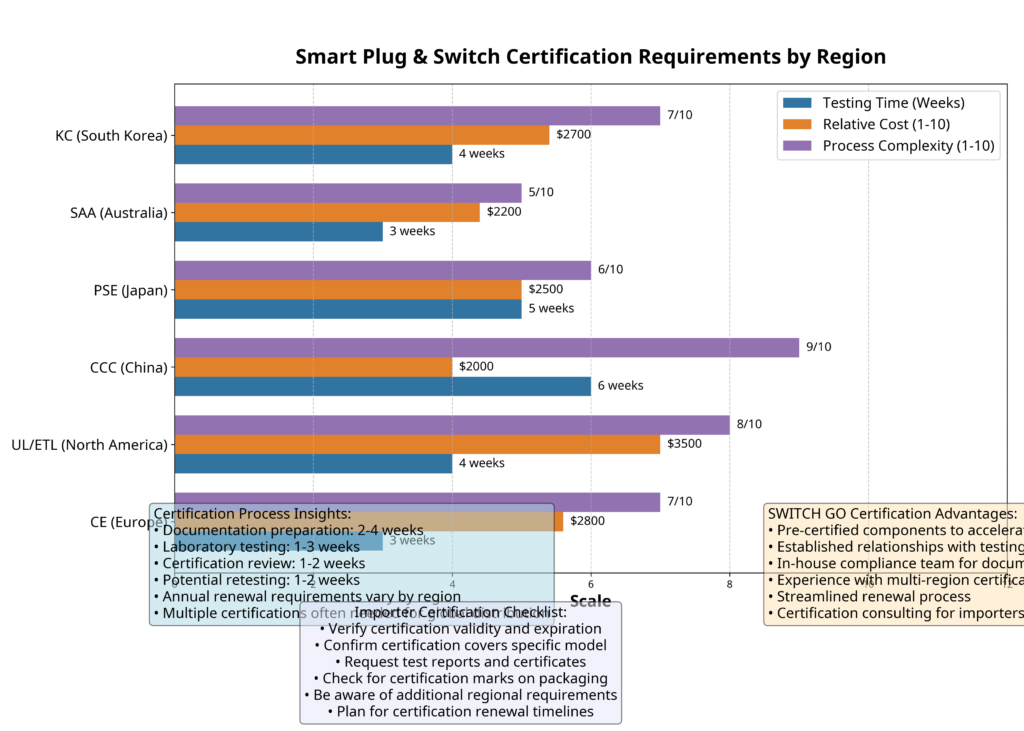
certification requirements comparison
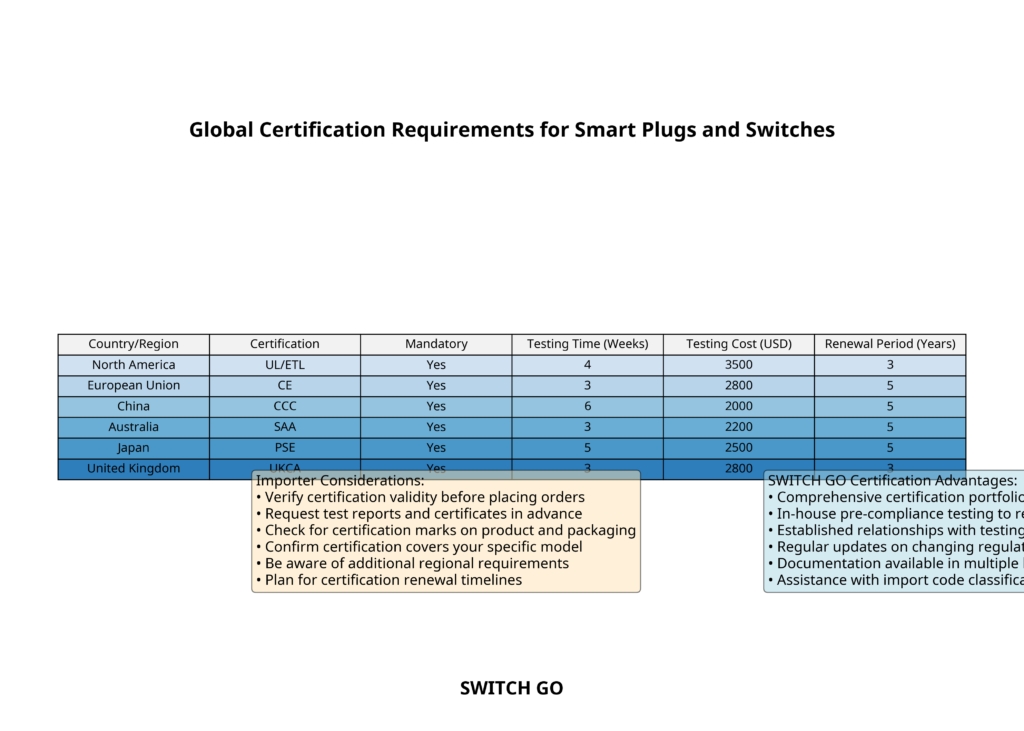
global certification requirements improved
For importers and manufacturers, navigating the complex landscape of certification requirements is essential for market access and consumer trust. At SWITCH GO, we’ve developed expertise in obtaining and maintaining certifications across global markets, and we understand the critical importance of compliance.
North American Certification Requirements
In the United States and Canada, several key certifications are mandatory for smart switches:
| Certification | Description | Issuing Body | Approximate Cost | Timeline |
|---|---|---|---|---|
| UL/ETL | Safety standard for electrical devices | UL LLC/Intertek | $5,000-$10,000 | 6-10 weeks |
| FCC | Electromagnetic compatibility and radio frequency compliance | Federal Communications Commission | $2,000-$5,000 | 3-6 weeks |
| Energy Star (optional) | Energy efficiency certification | Environmental Protection Agency | $3,000-$5,000 | 4-8 weeks |
The UL (Underwriters Laboratories) or ETL (Electrical Testing Laboratories) certification is particularly critical for switches, as they are permanently installed electrical devices with safety implications. The certification process involves rigorous testing of electrical safety, fire hazards, and overall product quality.
FCC certification focuses on ensuring that wireless devices don’t cause harmful interference to other electronics. For WiFi or Bluetooth-enabled smart switches, FCC Part 15 compliance is mandatory.
European Union Certification Requirements
For the European market, different certifications apply:
| Certification | Description | Issuing Body | Approximate Cost | Timeline |
|---|---|---|---|---|
| CE | Conformity with health, safety, and environmental protection standards | Self-declaration (with required testing) | €3,000-€6,000 | 3-6 weeks |
| WEEE | Proper disposal and recycling of electronic waste | National authorities | €1,000-€2,000 | 2-4 weeks |
| RoHS | Restriction of hazardous substances | National authorities | €1,500-€3,000 | 2-4 weeks |
| RED | Radio equipment safety and compatibility | Notified bodies | €2,000-€4,000 | 3-6 weeks |
The CE (Conformité Européenne) marking is mandatory for products sold in the European Economic Area. While technically a self-declaration, it requires comprehensive testing to demonstrate compliance with all relevant EU directives.
The Radio Equipment Directive (RED) is particularly relevant for smart switches with wireless capabilities, ensuring they meet safety, health, and electromagnetic compatibility requirements.
Asian Market Certification Requirements
For manufacturers targeting Asian markets, several region-specific certifications are necessary:
| Certification | Description | Issuing Body | Approximate Cost | Timeline |
|---|---|---|---|---|
| CCC (China) | Safety certification for Chinese market | China Quality Certification Centre | $3,000-$6,000 | 4-8 weeks |
| PSE (Japan) | Japanese safety standard | Japanese government | $2,500-$5,000 | 3-6 weeks |
| KC (South Korea) | South Korean safety and EMC certification | Korean government agencies | $2,000-$4,000 | 3-6 weeks |
| BIS (India) | Indian safety standard | Bureau of Indian Standards | $1,500-$3,000 | 4-8 weeks |
At SWITCH GO, we’ve found that planning for certification early in the product development process significantly reduces time-to-market and avoids costly redesigns. Our recommendation for importers is to verify that manufacturers have obtained all necessary certifications for target markets and can provide complete documentation.
Technical Specifications That Matter
When developing or sourcing smart switches, understanding the technical specifications that drive market success is crucial. Based on SWITCH GO’s experience in the smart switch market, we’ve identified the key technical aspects that matter most to consumers and retailers.
Power Ratings and Load Compatibility
Smart switches must be designed to handle the specific types of loads they’ll control:
| Load Type | Characteristics | Design Considerations |
|---|---|---|
| Resistive (incandescent, halogen) | Linear load, high inrush current | Robust relay or triac rating |
| Inductive (fans, motors) | Non-linear load, high startup current | Snubber circuits, higher safety margins |
| Capacitive (LED, CFL) | Non-linear load, high inrush current | Minimum load requirements, specialized dimming |
| Mixed loads | Combination of above | Most challenging design requirements |
It’s essential to clearly specify these ratings and ensure that the smart switch can safely handle the intended loads. Many consumer complaints stem from switches that work fine with incandescent bulbs but fail with LED lighting, or vice versa.
Connectivity Options
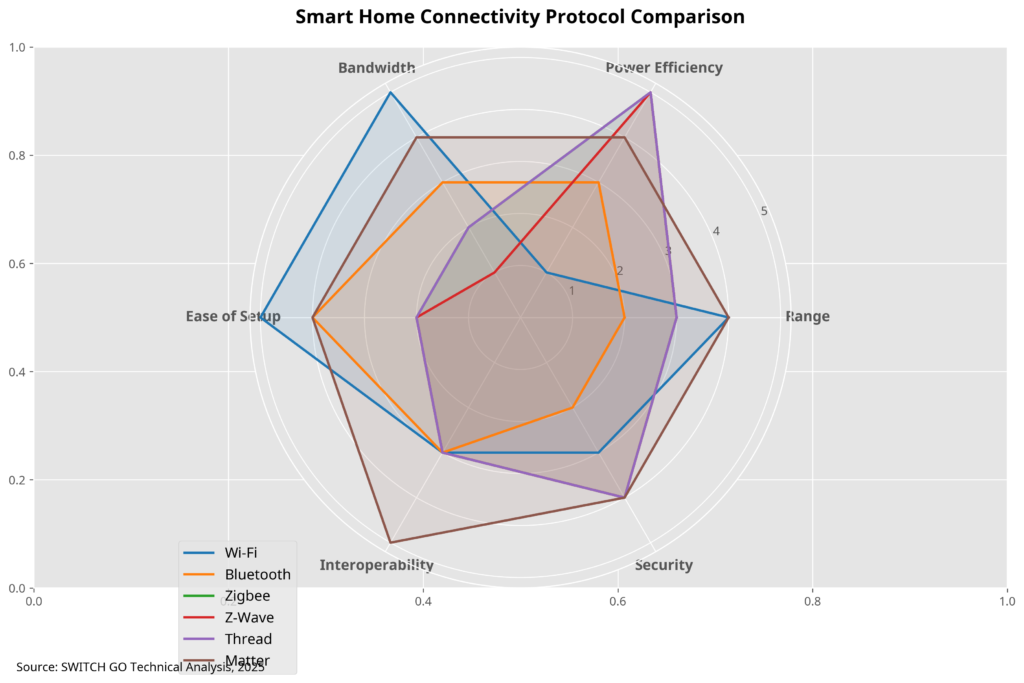
protocol comparison
The choice of connectivity protocol significantly impacts user experience, compatibility, and power consumption:
| Protocol | Advantages | Limitations | Best For |
|---|---|---|---|
| WiFi | No hub required, direct cloud connection | Higher power consumption, network congestion | Standalone installations, retrofit applications |
| Zigbee | Low power, mesh networking | Requires hub/gateway | Whole-home systems, battery options |
| Z-Wave | Reliable, less interference | Requires hub/gateway, higher cost | Professional installations, security integration |
| Bluetooth | Simple setup, direct control | Limited range, smartphone proximity required | Single-room applications, budget options |
| Thread/Matter | Future-proof, interoperability | Emerging standard, limited current support | Forward-looking installations |
At SWITCH GO, we offer switches with various connectivity options to meet different market needs, with WiFi models being our most popular for their simplicity and direct cloud connection without requiring additional hardware.
Installation Requirements
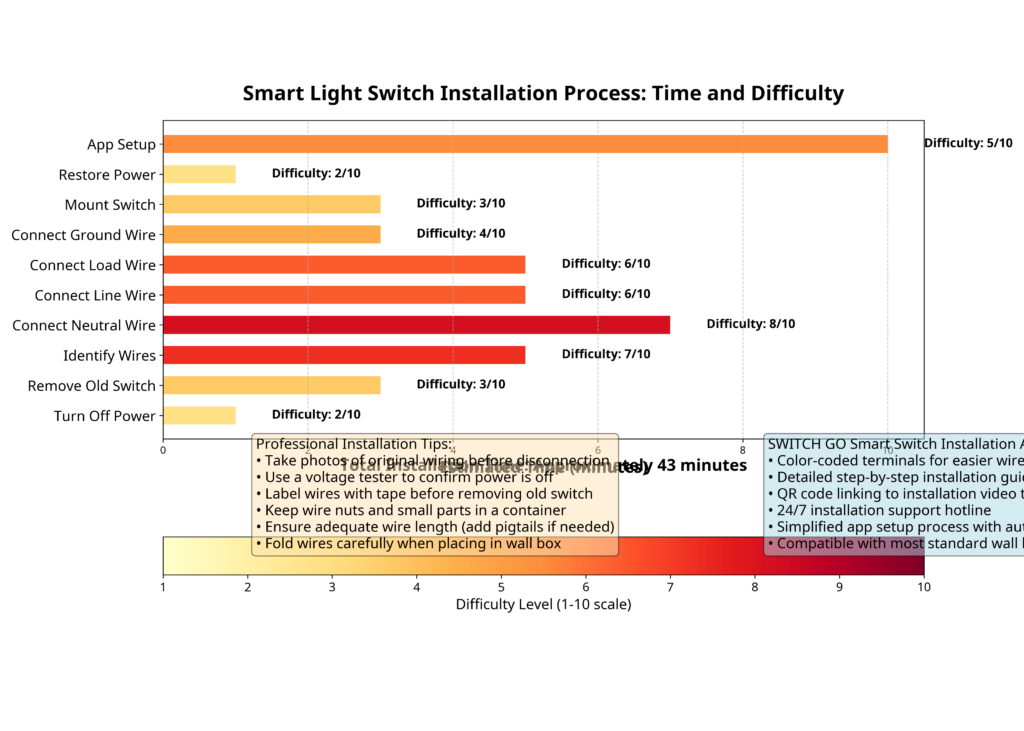
smart switch installation guide improved
Installation specifications can significantly impact market potential:
| Specification | Importance | Market Implications |
|---|---|---|
| Neutral wire requirement | Critical | Older homes often lack neutral wires at switch locations |
| Box depth requirement | High | Shallow boxes limit installation options |
| Load minimum/maximum | High | Determines compatibility with different lighting types |
| Single-pole vs. three-way | Medium | Three-way capability expands application range |
| Ground wire requirement | Medium | Safety consideration in older installations |
Our research at SWITCH GO indicates that neutral wire requirements remain the single biggest installation barrier. Our newer models include no-neutral options that can operate without this connection, significantly expanding the retrofit market potential.
User Interface and Control Options
The user interface significantly impacts consumer satisfaction:
| Control Method | Consumer Appeal | Implementation Complexity |
|---|---|---|
| Physical buttons | High (familiar) | Low |
| Touch surface | Medium-High (modern) | Medium |
| Voice control | Very High (convenient) | High (requires integration) |
| Motion/presence | Medium (automatic) | High (requires sensors) |
| App control | High (flexible) | Medium-High (requires development) |
The most successful smart switches offer multiple control methods, allowing users to choose the most convenient option for different situations. At SWITCH GO, our switches combine physical controls for immediate access with app and voice control for remote operation and automation.
Power Monitoring Capabilities
Energy monitoring features have become increasingly important:
| Feature Level | Capabilities | Implementation Complexity | Consumer Value |
|---|---|---|---|
| Basic | On/off status only | Low | Low |
| Intermediate | Current power consumption | Medium | Medium |
| Advanced | Historical usage, cost estimation | High | High |
While not as critical as in smart plugs, power monitoring in switches provides valuable data for energy management and can be a differentiating feature in competitive markets.
Manufacturing Considerations
For manufacturers and importers entering the smart switch market, understanding the production challenges and solutions is essential for delivering competitive products.
Component Selection and Quality Control
The reliability of a smart switch depends heavily on the quality of its components. Critical components include:
- Switching mechanism: Whether relay-based or using solid-state components like triacs, this is the heart of the switch. We recommend using components rated for at least 50,000 switching cycles.
- Microcontroller: The processing unit must balance performance with power efficiency. ESP32 and similar chips offer good performance for WiFi-enabled switches.
- Power supply circuit: Must be designed for efficiency and heat management, as this component often becomes a failure point in lower-quality switches.
- Touch sensors (if applicable): Should be responsive but not overly sensitive to prevent false triggers.
- LED indicators: Should be visible but not overly bright, particularly for bedroom installations.
At SWITCH GO, our quality control process includes 100% functional testing of assembled units and a minimum 48-hour burn-in test for a sample from each production batch. This approach has helped us maintain a defect rate below 0.3%, significantly lower than the industry average of 1-2%.
Production Challenges and Solutions
Smart switch manufacturing presents several challenges that importers should be aware of:
Challenge 1: Heat Dissipation
Smart switches generate heat during operation, particularly when controlling high loads. Inadequate thermal management can lead to premature failure or even safety hazards. Our solution involves strategic component placement, thermal pads for heat transfer, and housing designs that facilitate air circulation.
Challenge 2: Miniaturization
Fitting all required components into standard switch boxes is increasingly challenging as features expand. We address this through multi-layer PCB designs, careful component selection, and innovative 3D component arrangements.
Challenge 3: Certification Compliance
Meeting various regional certification requirements often necessitates design modifications. We address this by maintaining modular designs that can be easily adapted to different markets without complete redesigns.
Challenge 4: Firmware Reliability
Software issues can be as problematic as hardware failures. Our development process includes extensive testing across different network environments and load types, with automated regression testing for all firmware updates.
Cost Optimization Strategies
For competitive pricing without compromising quality, consider these cost optimization approaches:
- Design for manufacturing (DFM): Simplifying assembly processes can reduce labor costs by 15-20%.
- Component consolidation: Using integrated chips that combine multiple functions can reduce both component and assembly costs.
- Automated testing: Investing in automated testing equipment reduces quality control costs in the long run and improves detection of defects.
- Packaging optimization: Efficient packaging design can reduce shipping costs by up to 25% for bulk shipments.
- Scale economies: Planning production volumes strategically can significantly impact unit costs. At SWITCH GO, we’ve found that production runs of 10,000+ units typically reduce per-unit costs by 15-20% compared to smaller batches.
Sourcing Smart Switches: A Guide for Importers
For importers looking to enter the smart switch market, selecting the right manufacturing partner is perhaps the most critical decision. Based on SWITCH GO’s experience as both a manufacturer and market participant, we offer the following guidance.
Evaluating Manufacturers and Suppliers
When assessing potential smart switch suppliers, consider these key factors:
- Certification expertise: Verify that the manufacturer has successfully obtained relevant certifications for your target markets. Request sample certificates and test reports from previous products.
- Manufacturing capabilities: Assess production capacity, quality control processes, and technical expertise. A factory tour (virtual or in-person) can provide valuable insights.
- R&D capabilities: Determine whether the supplier can assist with customization and product improvements. This becomes particularly important for developing differentiated products.
- Business stability: Research the company’s history, client references, and financial stability. Suppliers with at least 3-5 years in the smart home industry typically offer more reliable partnerships.
- Communication and responsiveness: Evaluate communication quality during initial interactions. Prompt, clear communication often indicates better ongoing support.
Sample Testing and Verification
Before committing to large orders, thorough sample testing is essential:
- Functional testing: Verify all features work as specified, including app control, scheduling, and any special features.
- Compatibility testing: Confirm compatibility with popular smart home platforms and voice assistants.
- Safety testing: Conduct basic safety checks, including operation under maximum load and temperature monitoring.
- Durability testing: Test multiple on/off cycles and, if possible, conduct accelerated aging tests.
- User experience evaluation: Have potential customers test the product and provide feedback on the physical design and app interface.
At SWITCH GO, we recommend requesting at least 5-10 samples for comprehensive testing and being wary of suppliers unwilling to provide adequate samples for evaluation.
MOQ Negotiations and Pricing Structures
Minimum Order Quantity (MOQ) requirements can be a significant barrier for new importers. Effective negotiation strategies include:
- Phased ordering: Negotiate a smaller initial order with a commitment to larger follow-up orders upon successful market testing.
- Multiple product ordering: Combine orders for different products from the same manufacturer to reach MOQ thresholds.
- White-label options: Consider starting with a manufacturer’s existing design (white-labeled with your brand) to reduce MOQ requirements before investing in custom designs.
Typical pricing structures in the industry include:
| Order Volume | Expected Discount from Base Price |
|---|---|
| Sample quantities | 0% (often at premium) |
| MOQ (typically 1,000-2,000 units) | 0-5% |
| 5,000-10,000 units | 5-10% |
| 10,000-50,000 units | 10-15% |
| 50,000+ units | 15-25% |
Lead Times and Logistics Planning
Realistic lead time expectations are crucial for inventory planning:
- Development timeline: For custom designs, expect 3-4 months from concept to production-ready samples.
- Certification process: Allow 2-3 months for certification, depending on the regions targeted.
- Production lead time: Typically 30-45 days from order confirmation to shipping for standard orders.
- Shipping time: Sea freight typically takes 30-45 days to North America or Europe, while air freight reduces this to 5-10 days but at significantly higher cost.
For effective logistics planning, we recommend:
- Buffer inventory: Maintain at least 60-90 days of inventory to account for production and shipping delays.
- Phased shipping: Consider splitting large orders into multiple shipments to balance inventory costs with availability.
- Inspection services: Engage third-party inspection services for quality verification before shipment.
Value-Added Features That Drive Sales
In the competitive smart switch market, differentiation through value-added features can significantly impact market success. Based on SWITCH GO’s market research and sales data, these features deliver the strongest consumer appeal:
Advanced Control Options
Control flexibility has emerged as a key differentiator:
- Multi-way control: The ability to control a single light from multiple switch locations without complex wiring.
- Scene control: Dedicated buttons or interfaces for activating predefined scenes beyond the switch’s direct control.
- Gesture control: Motion-based activation without physical contact, particularly valuable in kitchen and bathroom settings.
- Contextual awareness: Switches that adapt behavior based on time of day, occupancy, or other environmental factors.
Our data shows that advanced control options can justify a 20-30% price premium and significantly reduce return rates by increasing perceived value.
Aesthetic Customization
As smart switches move from early adopters to mainstream consumers, aesthetic considerations have gained importance:
- Interchangeable faceplates: Systems allowing users to change colors or materials without replacing the entire switch.
- Customizable LED indicators: Ability to adjust color, brightness, or behavior of status lights.
- Minimalist designs: Options that blend seamlessly with high-end interior design.
- Consistent family look: Coordinated appearance across different switch types (single-pole, three-way, dimmer, etc.).
These customization options help overcome consumer resistance to visible technology in carefully designed living spaces.
Voice Control Integration
Voice assistant compatibility has become a standard expectation rather than a premium feature. The quality of this integration, however, varies significantly:
- Multi-assistant support: Compatibility with Amazon Alexa, Google Assistant, and Apple HomeKit provides maximum market coverage.
- Natural language processing: Supporting conversational commands rather than rigid syntax improves user experience.
- Contextual awareness: Understanding commands in context of previous interactions or current home state.
- Local voice processing: Offering basic voice control functionality even when internet connectivity is lost.
At SWITCH GO, we’ve found that robust voice control integration correlates strongly with positive user reviews and reduced support inquiries.
Smart Home Platform Integration
Beyond basic compatibility, deep integration with smart home platforms offers significant value:
- Native platform appearance: Appearing as a first-class device within platform interfaces rather than requiring separate apps.
- Conditional automation: Participating in if-then rules and complex automation scenarios.
- Sensor integration: Working with motion, light, or temperature sensors to provide contextual control.
- Energy dashboards: Contributing data to whole-home energy monitoring systems.
This integration transforms switches from standalone devices to integral components of a comprehensive smart home ecosystem.
Enhanced Safety Features
Safety features provide both practical benefits and marketing advantages:
- Overload protection: Automatically cutting power when maximum load is exceeded.
- Overheating prevention: Temperature monitoring with automatic shutdown if unsafe conditions are detected.
- Child safety features: Physical or app-based controls to prevent unauthorized usage.
- Away mode simulation: Randomized operation patterns when homeowners are away to simulate occupancy.
These safety features not only protect users but also reduce liability concerns and can be powerful marketing differentiators.
Case Study: SWITCH GO’s Smart Switch Success Story
At SWITCH GO, our journey in the smart switch market offers valuable insights for importers and manufacturers. Our flagship SS-200 WiFi Smart Switch with Scene Control illustrates the path from concept to market success.
Product Development Journey
Our development process began with comprehensive market research, identifying a gap for a premium smart switch with enhanced scene control capabilities. Key development milestones included:
- Initial concept and requirements gathering: 6 weeks
- Competitive analysis of 12 leading products
- Focus groups with 40+ potential users
- Technical requirement specification
- Design and prototyping: 10 weeks
- Electrical engineering and component selection
- Industrial design for premium aesthetics
- Initial prototype production and testing
- Software development: 14 weeks (concurrent with hardware)
- Mobile app development for iOS and Android
- Cloud infrastructure setup
- Voice assistant integration
- Testing and refinement: 8 weeks
- Beta testing with 75 users
- Reliability testing (20,000+ on/off cycles)
- Security penetration testing
The entire development cycle took approximately 8 months from concept to production-ready design, with an investment of approximately $150,000 in R&D.
Certification Process Overview
Our certification strategy prioritized major markets while managing costs:
- Pre-certification preparation: Internal testing against certification requirements to identify potential issues early.
- Certification body selection: We selected UL for North American certification due to their strong retail recognition, despite higher costs compared to ETL.
- Simultaneous submissions: We pursued UL, CE, and CCC certifications concurrently to minimize time-to-market.
- Documentation preparation: Comprehensive technical files were prepared in-house to reduce consultant costs.
The certification process took approximately 12 weeks and cost $20,000 across all target markets. This investment proved worthwhile, as several major retailers require UL certification specifically.
Market Entry Strategy
Our go-to-market approach focused on building credibility before pursuing volume:
- Initial launch: Limited release through our direct-to-consumer website to gather real-world feedback and refine marketing messaging.
- Online marketplace expansion: Expansion to Amazon and other e-commerce platforms, with heavy investment in product photography and detailed listings.
- Retail partnerships: Leveraging initial success to secure placement with specialty smart home retailers.
- OEM/ODM opportunities: Offering white-label and customized versions to established brands looking to enter the smart switch category.
This phased approach allowed us to refine our product and messaging before committing to large production volumes.
Customer Feedback and Continuous Improvement
Post-launch, we implemented a structured feedback loop:
- Automated feedback collection: In-app surveys at key usage milestones.
- Review monitoring: Systematic analysis of online reviews to identify common praise and complaints.
- Support ticket analysis: Monthly review of support issues to identify potential product improvements.
- Firmware and app updates: Regular updates based on user feedback, with an average release cycle of 6-8 weeks.
This approach led to several significant improvements:
- Enhanced three-way switch compatibility
- Improved dimming performance with challenging LED loads
- Added customizable LED indicator brightness
- Expanded voice command vocabulary for more natural interaction
Future Trends in Smart Switch Technology
As we look toward the future of smart switch technology, several emerging trends will shape the market landscape. Importers and manufacturers should consider these developments when planning their product roadmaps.
Matter Protocol Adoption
The Matter protocol, backed by major technology companies including Amazon, Apple, Google, and Samsung, promises to revolutionize smart home interoperability. For smart switches, Matter adoption offers several advantages:
- Simplified certification: A single certification process covering multiple ecosystems.
- Enhanced interoperability: Seamless operation across different smart home platforms.
- Improved reliability: Local control capabilities reducing cloud dependency.
- Stronger security: Standardized security requirements and implementation.
At SWITCH GO, we’re already incorporating Matter compatibility into our product development roadmap, with our first Matter-certified smart switches scheduled for release in Q3 2025.
Energy Management Integration
Smart switches are evolving beyond simple control devices to become integral parts of home energy management systems:
- Load shedding capabilities: Participating in demand response programs from utility companies.
- Renewable integration: Coordinating with solar production and battery storage systems.
- Time-of-use optimization: Automatically adjusting operation based on electricity pricing.
- Energy disaggregation: Contributing to whole-home energy monitoring through load signatures.
These capabilities position smart switches as valuable components in the broader trend toward more energy-efficient homes.
Enhanced Sensing Capabilities
The integration of additional sensors into smart switches expands their functionality beyond simple control:
- Ambient light sensing: Automatically adjusting lighting based on natural light levels.
- Occupancy detection: Built-in motion or presence detection for automated control.
- Temperature monitoring: Contributing to whole-home climate management.
- Air quality sensing: Monitoring environmental conditions for health and comfort.
By incorporating these sensing capabilities, smart switches become multi-functional devices that provide value beyond their primary control function.
Aesthetic Evolution
As smart switches move further into the mainstream market, aesthetic considerations continue to evolve:
- Invisible technology: Designs that hide technological elements behind clean, architectural interfaces.
- Material innovation: Incorporation of premium materials like glass, metal, and sustainable composites.
- Customization options: User-replaceable components to match changing decor.
- Architectural integration: Switches designed to complement specific architectural styles.
These aesthetic improvements address the concerns of design-conscious consumers who have been hesitant to adopt visibly technological products in their homes.
AI-Powered Functionality
Artificial intelligence is increasingly being applied to smart switch operation:
- Learning user preferences: Automatically adapting to usage patterns without explicit programming.
- Predictive control: Anticipating user needs based on historical behavior.
- Anomaly detection: Identifying unusual patterns that might indicate problems.
- Natural language processing: Enabling more intuitive voice control interactions.
These AI capabilities transform smart switches from reactive devices to proactive participants in home management.
FAQ Section
Certification and Compliance
Q: What certifications are absolutely essential for selling smart switches in the US market?
A: For the US market, UL or ETL certification is essential for safety compliance, and FCC certification is required for all wireless devices. Most major retailers and e-commerce platforms will not list products without these certifications. Additionally, some states have specific requirements – for example, California requires compliance with Title 24 energy efficiency standards for certain switch applications. At SWITCH GO, we ensure all our products meet these requirements to provide seamless market access for our partners.
Q: How do certification requirements differ for low-voltage smart switches versus line voltage models?
A: Low-voltage smart switches (typically 12-24V DC) face less stringent safety certification requirements than line voltage models (120-240V AC). While line voltage switches require full UL/ETL certification to UL 1472 standards in North America, low-voltage models may qualify for simplified certification processes. However, both types require FCC certification for wireless capabilities. The certification cost difference can be substantial, with low-voltage certifications typically costing 30-50% less than line voltage equivalents.
Q: Can I use European CE certification to sell in North America while waiting for UL certification?
A: No, CE certification is not recognized or accepted in North America as an alternative to UL/ETL certification. Attempting to sell CE-only certified electrical products in the US or Canada could result in regulatory issues, retailer rejection, and potential liability concerns. While pursuing UL certification, consider starting with low-risk markets where CE is accepted or focus on direct-to-consumer channels where certification requirements may be less strictly enforced, though this approach carries its own risks.
Technical Specifications
Q: What’s the difference between relay-based and solid-state smart switches?
A: Relay-based smart switches use mechanical relays to physically connect or disconnect the circuit, while solid-state switches use semiconductor components like triacs. Relay switches produce an audible click when switching, have higher current handling capabilities, and work with a wider range of load types. Solid-state switches operate silently, have longer theoretical lifespans due to no mechanical wear, and are essential for dimming functionality. At SWITCH GO, we use relay technology for our standard on/off switches and solid-state technology for our dimmer models.
Q: How do I determine if a smart switch will work with my existing wiring?
A: To determine compatibility, you need to know: 1) Whether you have neutral wires at your switch locations (white wires, usually bundled in the back of the box); 2) The type of load you’re controlling (LED, incandescent, fan, etc.); 3) Whether it’s a single-pole or multi-way switching setup; and 4) The physical dimensions of your switch boxes. Most modern smart switches require neutral wires, though some newer models offer no-neutral options. SWITCH GO provides detailed wiring compatibility guides and offers both neutral and no-neutral models to accommodate different installation scenarios.
Q: Can smart switches work with three-way or four-way switch configurations?
A: Yes, but the implementation varies by manufacturer. Some systems require special companion switches at the secondary locations, while others use standard momentary switches or wireless remotes. The most advanced systems allow any switch in the circuit to be a fully functional smart switch. When selecting products for three-way or four-way applications, verify that the manufacturer specifically supports these configurations and provides clear installation instructions for your particular wiring scenario.
Importing and Manufacturing
Q: What’s a realistic minimum order quantity (MOQ) for custom-designed smart switches?
A: For fully customized smart switches with unique hardware and firmware, typical MOQs range from 3,000-5,000 units. For semi-customized products (standard hardware with custom firmware and branding), MOQs may be lower, around 1,500-3,000 units. White-label products with only branding customization might be available with MOQs as low as 1,000 units. At SWITCH GO, we offer flexible MOQ options depending on the level of customization required, with our OEM services accommodating various business scales.
Q: How can I verify that a manufacturer’s certifications are legitimate?
A: Legitimate certifications can be verified through the certification body’s online database. For UL certifications, check the UL Product iQ database (productiq.ulprospector.com). For ETL, verify through Intertek’s directory (intertek.com/directory). FCC certifications can be confirmed through the FCC ID Search (fccid.io). Always request the specific certification number or ID and verify it independently rather than relying solely on certificates provided by the manufacturer.
Q: What quality control measures should I expect from a reliable manufacturer?
A: A reputable smart switch manufacturer should implement multiple quality control stages: component inspection before assembly, in-line quality checks during production, 100% functional testing of finished products, and batch sample testing for durability and performance. Ask potential manufacturers about their defect rate, testing procedures, and quality control documentation. Request their quality control manual and consider engaging a third-party inspection service for initial orders.
Market and Business Considerations
Q: How can I differentiate my smart switch product in a crowded market?
A: Differentiation can come through several avenues: superior design aesthetics, enhanced functionality (like built-in sensors or energy monitoring), specialized features for specific use cases (hospitality, commercial, etc.), or integration with emerging smart home standards like Matter. Additionally, exceptional app experience, stronger customer support, or longer warranty periods can provide meaningful differentiation even with similar hardware. At SWITCH GO, we’ve found that focusing on premium design and multi-platform compatibility has allowed us to stand out in competitive markets.
Q: What pricing strategy works best for new entrants to the smart switch market?
A: For new market entrants, a tiered pricing strategy often works best – offering good-better-best options that allow consumers to select their preferred balance of features and price. Entry-level models should be competitively priced to drive initial adoption, while premium models can command higher margins through differentiated features. As a general guideline, basic smart switches typically retail for $25-35, mid-range models with enhanced features for $35-50, and premium models with advanced capabilities for $50-80.
Q: How important is the mobile app experience for smart switch success?
A: The mobile app experience is extremely important – it’s the primary interface between users and the product. Our research shows that over 50% of negative reviews for smart switches relate to app issues rather than hardware problems. Invest in professional UI/UX design, thorough app testing across different devices, and regular updates. Consider whether to develop a proprietary app or leverage existing platforms like Smart Life or Tuya, weighing control and branding against development costs and maintenance requirements.
Conclusion
The smart switch market presents a compelling opportunity for importers and manufacturers in 2025 and beyond. With steady growth projections, increasing consumer adoption, and evolving feature sets, smart switches continue to serve as both standalone products and integral components of broader smart home ecosystems.
Success in this competitive landscape requires attention to several key factors:
- Certification compliance: Ensuring products meet all safety and regulatory requirements for target markets.
- Technical excellence: Delivering reliable performance, connectivity, and user experience.
- Manufacturing quality: Implementing rigorous quality control to build consumer trust and minimize returns.
- Value-added features: Differentiating products through enhanced control options, platform integration, and aesthetic design.
- Forward-looking development: Anticipating market trends like Matter adoption and AI integration.
At SWITCH GO, we’re committed to advancing smart switch technology and supporting our partners in navigating this dynamic market. Our expertise as both manufacturers and market participants gives us unique insights into the challenges and opportunities in the smart home ecosystem.
Founded in 2019 with our philosophy of “Switch Smarter, Live Easier,” we’ve established ourselves as a leading provider of smart home solutions based in Shenzhen. Our products are compatible with all major smart home platforms including Tuya, EweLink, Amazon Alexa, Google Home, and SmartThings, ensuring maximum market reach and consumer satisfaction.
For importers and manufacturers looking to enter or expand in the smart switch market, we offer consultation services, OEM/ODM manufacturing capabilities, and certification support. Contact our team to discuss how we can help you succeed in the smart switch market.
This article was produced by SWITCH GO, a leading smart home technology company based in Shenzhen, China. With our founding in 2019 and our commitment to helping consumers “Switch Smarter, Live Easier,” SWITCH GO combines technical expertise with market insights to deliver innovative solutions for global markets.
